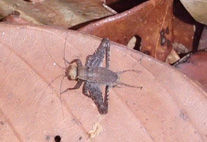Abstract
Whether or not a species might reasonably be described without the preservation of a type specimen is a matter of ongoing discussion among taxonomists (Dubois & Nemésio 2007; Minteer et al. 2014; Krell & Wheeler 2014; Löbl et al. 2016; Marshall & Evenhuis 2016; Santos et al. 2016). Here, we attempt to make our own contribution to the topic.
References
Aescht, E. (2008) Annotated catalogue of “type material” of ciliates (Ciliophora) and some further protists at the Upper Austrian Museum in Linz, including a guideline for “typification” of species. Denisia, 23, 125–234.
Dubois, A. (2009) Endangered species and endangered knowledge. Zootaxa, 2201, 26–29.
Dubois, A. & Nemésio, A. (2007) Does nomenclatural availability of nomina of new species or subspecies require the deposition of vouchers in collections? Zootaxa, 1409, 1–22.
Foissner, W. (2002) Neotypification of protists, especially ciliates (Protozoa, Ciliophora). Bulletin of Zoological Nomenclature, 59, 165–169.
Gentile, G. & Snell, H. (2009) Conolophus marthae sp.nov. (Squamata, Iguanidae), a new species of land iguana from the Galápagos archipelago. Zootaxa, 2201, 1–10.
ICZN [International Commission on Zoological Nomenclature] (1999) International code of Zoological Nomenclature. Fourth edition. International Trust for Zoological Nomenclature, London, XXIX + 306 pp.
Krell, F.T. & Wheeler, Q.D. (2014) Specimen collection: plan for the future. Science, 344, 815–816.
http://dx.doi.org/10.1126/science.344.6186.815Lapage, S.P., Sneath, P.H.A., Lessel, E.F., Skerman, V.B.D., Seeliger, H.P.R. & Clark, W.A. (1992) International Code of Nomenclature of Bacteria (1990 Revision). Bacteriological Code. American Society for Microbiology, Washington (DC).
Löbl, I., Cibois, A. & Landry, B. (2016) Describing new species in the absence of sampled specimens: a taxonomist’s own-goal. Bulletin of Zoological Nomenclature, 73, 83–86.
Marshall, S.A. & Evenhuis, N.L. (2015) New species without dead bodies: a case for photo-based descriptions, illustrated by a striking new species of Marleyimyia Hesse (Diptera, Bombyliidae) from South Africa. ZooKeys, 525, 117–127.
http://dx.doi.org/10.3897/zookeys.525.6143Marshall, S.A. & Evenhuis, N.L. (2016) Proxy types, taxonomic discretion, and taxonomic progress: a response to Löbl et al. Bulletin of Zoological Nomenclature, 73, 87–92.
McNeill, J., Barrie, F.R., Buck, W.R., Demoulin, V., Greuter, W., Hawksworth, D.L., Herendeen, P.S., Knapp, S., Marhold, K., Prado, J., Prud’homme van Reine, W.F., Smith, G.F., Wiersema, J.H. & Turland, N.J. (2012) International Code of Nomenclature for algae, fungi, and plants (Melbourne Code) adopted by the Eighteenth International Botanical Congress Melbourne, Australia, July 2011. Koeltz, Königstein, XXX + 240 pp.
Minteer, B.A., Collins, J.P. & Puschendorf, R. (2014.) Avoiding (re)extinction. Science, 344, 260–261.
http://dx.doi.org/10.1126/science.1250953Santos, C.M.D., Amorim, D.S., Klassa, B., Fachin, D.A., Nihei, S.S., De Carvalho C.J.B., Falaschi, R.L., Mello-Patiu, C.A., Couri, M.S., Oliveira, S.S., Silva, V.C., Ribeiro, G.C., Capellari, R.S. & Lamas, C.J.E. (2016) On typeless species and the perils of fast taxonomy. Systematic Entomology, 41, 511–515.
http://dx.doi.org/10.1111/syen.12180

